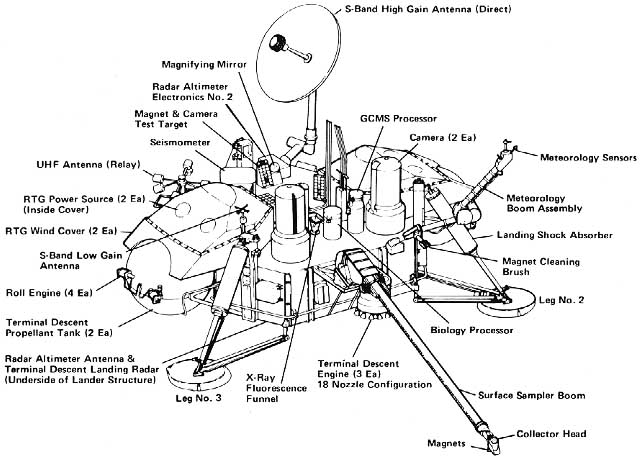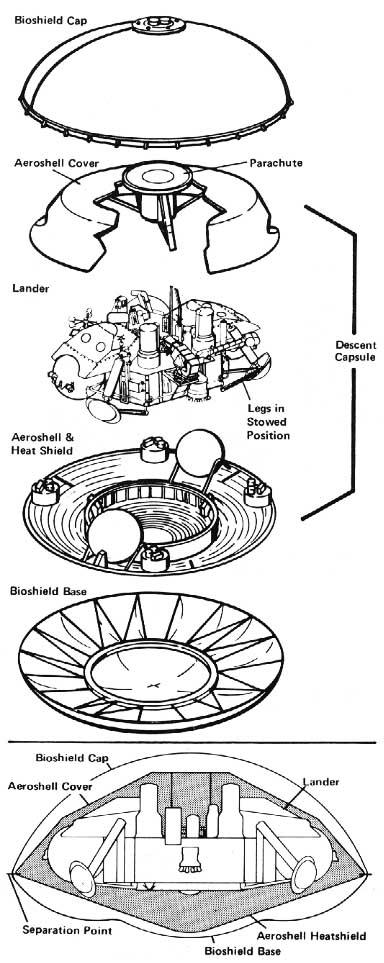-
On Mars:
Exploration of the Red Planet. 1958-1978
-
-
-
- LANDER MISSION
PROFILE
-
-
-
- [244] Jim Martin and his colleagues
hoped the lander mission would follow the ideal schedule: Final
prelaunch activities begin 56 days before launch with the terminal
sterilization of the entire lander system within its bioshield.
The craft must survive a 40-hour sterilization cycle, during which
temperatures will reach a maximum of 112°C. During this
preparation period, the lander is functionally passive except for
its two mass-spectrometer ion pumps. Following a checkout, the
propellants, pressurants, and flight software are loaded, and the
lander is mated with the orbiter. After the first prelaunch
checkout, initiated by the orbiter under local control of the
guidance computer, the spacecraft is encapsulated, transported to
the launch pad, and mated with the launch vehicle, followed by the
second and final prelaunch checkout. All major communication with
the lander before separation is accomplished through the orbiter
communications link.
-
- During the launch and boost phases, only
the power and pyro controllers, the data acquisition system, and
the tape recorder are active. After the spacecraft separates from
the launch vehicle, the orbiter commands the lander computer to
separate the bioshield cap and begins the lander cruise state.
During cruise, the lander is largely passive. Only the data
acquisition system, ion pumps, and thermostatically controlled
heaters on propulsion equipment, the biology instrument, and the
inertial reference unit are powered. The heaters prevent the
freezing of propellants and biology nutrients. Heat also controls
viscosity of the gyro flotation fluids. The primary
[245] housekeeping chore during the cruise phase is
monitoring the thermal balance and the equipment when it is
powered.
-
- The tape recorder is activated about every
15 days to ensure its later performance. An update to the computer
requires the activation of the computer and the command detectors
and decoders. The portion of the computer memory used during
prelaunch checkout procedures is modified during the cruise so
that it can perform other operations during the mission. The gas
chromatograph-mass spectrometer requires a venting-and-bakeout
sequence to rid the analyzer section of absorbed gases. For
bakeout, with its high peak-power demand, the lander batteries are
first conditioned and charged using orbiter power; the computer,
detectors, and decoders are powered up; and a six-hour bakeout
sequence is commanded from Earth, followed by a week-long cooldown
period to reestablish the proper thermal equilibrium. About five
such cycles in two groups are required, each accompanied by
mass-spectrometer readings, which are analyzed to determine the
performance and health of the instrument. After each activity, the
lander is powered back to cruise state and, after the final
bakeout of the gas chromatograph-mass spectrometer, a cruise check
is made and the batteries discharged. About 52 days before
reaching Mars, the final conditioning and charge cycle is
undertaken for the lander batteries.
-
- Before the lander separates from the
orbiter, a four-and-one-half-hour checkout verifies the lander
systems' health. A group of orbit commands precedes this last
check, during which local control is assumed by the lander
computer and power is transferred from the orbiter to the lander.
At checkout completion, the computer memory is read out, the
batteries are recharged on internal power, and the computer
reverts to standby. After cruise checkout, power is transferred
back to the orbiter, which assumes control. The next events
prepare the lander for its release. For eight hours, the
radioisotope thermoelectric generators recharge the lander's
batteries.
-
- Twelve hours before separation-318 days
into the mission-an orbiter commander turns on lander command
detectors and decoders, placing the lander under the control of
its own computer. Mission control commands update descent
information and carry out checkout decisions made by the
operations team. The commands are directed to the lander via its
S-band receivers. A memory readout follows update, and the lander
assumes a standby mode. This sequence is repeated three and
one-half hours before separation. About two and one-half hours
before separation, direct orbiter command starts the separation
sequence. Final preparations begin with warming up the inertial
reference unit to its operating temperature. At 37 minutes before
separation, a final "go" is uplinked from Earth and received by
the lander 15 minutes before separation. At this point,
valve-drive amplifiers, pyrotechnic controllers, entry thermal
control, and relay communications link are activated. A final
check verifies that the inertial reference unit has transferred to
the entry condition and that all systems are go. If these checks
fail, the lander is powered down and transferred to the update
mode. If the checks pass, the telemetry system is....
-
-
-

-
- [246] Lander details
-
-
- ....switched to an entry mode, the
bioshield base connectors between orbiter and lander are
separated, and the lander-orbiter separation pyrotechnic devices
are fired.
-
- Immediately after separation, attitude
control-deorbit propulsion is readied by opening the isolation
valves. After inertial reference unit calibration, attitude
control is initiated by orienting for the deorbit burn. The burn
is delayed until the lander capsule is far enough away from the
orbiter that the orbiter's solar panels will not be damaged or
contaminated. The pitch yaw engines supply the deorbit impulse
with a 23-minute burn. The control system ensures that the lander
is in the proper position for the entry science experiments to
function. The retarding-potential analyzer and the
upper-atmosphere mass spectrometer collect data during the
three-hour descent.
-
-
- Entry and Landing
-
-
- After orienting the lander in preparation
for entry into the Martian atmosphere, the control system turns on
the radar altimeter, which assumes the high-altitude search mode.
On sensing 0.05 g with the longitudinal accelerometer, the
attitude control system is adjusted, and the computer begins
radar-altimeter data processing. Aerodynamic forces quickly trim
the entry vehicle to about a - 11° angle of attack,
corresponding to the lander's....
-
-
- [247] Landing capsule
system

-
-
-
-
- [248]....offset center of gravity.
Instruments collect additional entry science data for pressure and
temperature during the remainder of the deceleration
period.
-
- At 5.5 kilometers above Mars, the computer
begins parachute deployment based on radar range to the surface.
Terminal-propulsion valve-drive amplifiers power tip, the
aeroshell separates from the lander, and the
terminal-roll-propulsion isolation valves open within about seven
seconds after parachute deployment. Radar-altimeter changes occur
with separation of the aeroshell, and a lander body-mounted
antenna switches into use. The four-beam doppler terminal-descent
and landing radar is also activated to sense velocity relative to
the surface. The lander's legs are deployed from their stowed
position.
-
- At about 1.5 kilometers above the surface,
the computer initiates another radar-altimeter mode change and
shortly thereafter opens the terminal-propulsion isolation valves.
The parachute-base cover assembly separates from the lander, and
the lander descends toward the surface under three-axis attitude
control. The control system and engines halt the horizontal
velocity acquired while on the parachute by tilting the entire
lander upwind. At the same time, residual vertical velocity is
stopped. On sensing 610 meters to the surface, the radar altimeter
switches to low-altitude mode; the low-altitude mode for the
terminal-descent and landing radar begins at 100 meters. At about
50 meters, vertical navigation continues inertially, ignoring
radar-altimeter data. At 17 meters, the terminal engine-shutdown
switches are armed, and a constant velocity descent is initiated
to maintain a speed of 1.5 meters per second until landing-leg
touchdown. Velocity steering continues. using the terminal-descent
and landing radar. On sensing closure of the
terminal-engine-shutdown switches, the computer commands shutdown
of the terminal propulsion system by closing a pyro-activated
isolation valve, backed up by a software timer.
-
-
- Landed Operations
-
-
- The landed mission begins with several
housekeeping chores, which include shutting down all descent
guidance and control equipment except the computer and the
inertial reference unit; the latter operates five more minutes to
establish the local vertical altitude and the direction of north.
This information is used to compute the direction of Earth so the
high-gain antenna can be accurately pointed the following day.
Protective devices are armed but not yet activated, the telemetry
is set to the highest relay data rate mode of 16 kilobits per
second, and the first real-time imaging sequence is begun. A
multiple readout of about 25 percent of the computer's memory
follows.
-
- After deploying the high-gain antenna and
the meteorology boom, opening the camera dust-removal valve, and
opening the cover to the biology-processor and distribution
assembly, all mission pyrotechnic events are completed. A second
real-time imaging sequence begins and continues until the orbiter
disappears over the horizon. The relay link fades [249] out
about 10 to 12 minutes after landing and, at 15 minutes after, the
transmitter is shut off. The meteorology instrument and the
seismometry instruments are turned on, and the high-gain antenna
is stowed to its normal rest position. Finally, the adaptive
mission is begun by activating the mission sequence of
events.
-
- Before the Viking landers had the
opportunity to perform this complex series of events on Mars,
managers, scientists, and engineers faced a multitude of problems
on Earth.
-
-
-


















